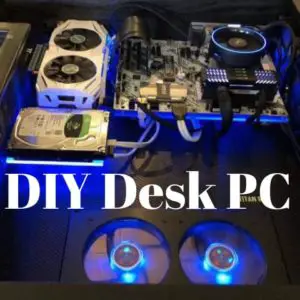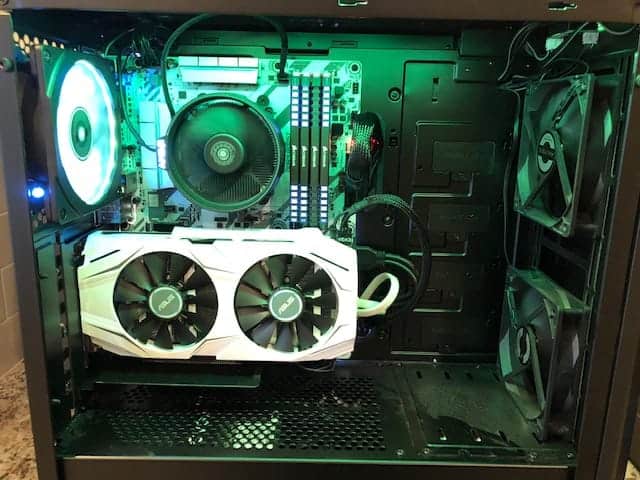There are two types of graphics cards, dedicated and integrated. Dedicated cards are a separate component that needs to be added to the motherboard; they have their own RAM and are typically more powerful than their integrated counterparts. Integrated GPUs share the same chip or motherboard as your CPU. They rely on your system memory and are slower but they are much smaller and cheaper than dedicated GPUs.
So, do you need a dedicated GPU? A dedicated graphics card is needed if you want to play the latest games on the highest settings or use resource-intensive programs like CAD simulations and animation software. However, if you use your computer for surfing the web, watching movies, office work, or casual gaming, an integrated GPU can do everything you need.
To truly understand how graphics are calculated and displayed by the graphics processor, read Does a Computer Need a GPU? Yes…And Here’s Why!
Is Dedicated Graphics Better For Gaming?
The first step in evaluating whether or not you need a dedicated graphics card is investigating the games you want to play. Every game publisher lists the minimum and recommended system requirements of their games.
You can see their recommended graphics cards and compare them to your own. If you’re unsure how to compare graphics cards, you can use the Can You RUN it app from System Requirements Lab to automatically check your system specs against any game you want to play.
Note: You will have to download the System Requirements Lab Detection desktop app to run their checks.
If your graphics card meets the recommended specifications, then you can open and play the game with no problems. Next, you need to consider the gaming experience you want to have.
If you don’t mind lower frame rates and resolution, then an integrated graphics card might be all you need. In fact, according to the video game distribution platform Steam, 9.65% of its users have Intel® integrated graphics cards (source).
However, if you want to have better performance with stable 60+ fps, moderate to high resolution, and modding capability, you might consider a more powerful dedicated graphics card.
To illustrate these points let’s look at the minimum system requirements of some of today’s most popular video games:
| Minimum GPU | Integrated | GPU clock speed | |
| Minecraft | Intel HD Graphics 4000 | Yes | 650 MHz |
| League of Legends | AMD Radeon HD 5670 | No | 775 MHz |
| Fortnight | Nvidia GTX 660 | No | 980 MHz |
Minecraft is the only game that accepts an integrated chip for its minimum requirements. This is because, though Minecraft is 3D, it only renders as far as your system can handle, reducing GPU strain. Contrasting this is League of Legends and Fortnight both of which feature real-time combat and a more fleshed out 3D graphics system with larger rendered game worlds.
Minimum requirements are what’s needed to make the game function at a base level. Each of these games requires nonintegrated cards for its recommended settings. When it comes to gaming a modern dedicated card will allow you to play most games at an acceptable frame rate and resolution. Integrated graphics can work for lower resolution games with fewer detailed assets.
Do You Need A Dedicated Graphics Card For Video Editing?
Contrary to what many think, graphics cards are not as critical for video editing as for gaming. This is because your CPU is running the actual editing software. It is also responsible for the calculations done during playback and rendering.
In many cases, you might not need a dedicated graphics card to edit videos. But without one, the video editing process can be excruciatingly slow, especially if you are running other programs at the same time. To help with this problem, GPUs are now being used in video editing, via GPU accelerated computing.
Accelerated computing uses the GPU as a secondary processor. This allows the CPU to tackle the computationally complex parts of editing and leaves the repetitive rendering calculations to the GPU. This leaves more processing power to run other programs during the rendering phase without freezing your computer.
This has become so commonplace that many professional editing programs, such as Adobe Premiere Pro, recommend GPUs in their system requirements (source).
When buying a GPU for video editing, be careful as not all GPUs support acceleration. Be sure to read the recommended GPUs in the system requirements for your specific editing program.
What About A GPU For Photo Editing?
Photo editing is not graphically intensive. Almost every aspect of the editing process is governed by your CPU. The GPU is only really used during select processes such as zooming, 3D work, and rotations (source).
In this case, investing in a good CPU can seriously boost performance. But anything beyond a moderately powerful GPU is overkill. Even integrated graphics can handle all but the most advanced effects.
One point to consider is GPU acceleration. Photoshop has been increasing support for this over the past few years, and if you want the absolute fastest Photoshop experience you can try a dedicated graphics card (source).
Can You Add A GPU To A Laptop?
Changing or adding a GPU to a desktop PC is a relatively simple process. You just open the case, take out any existing GPU, and add your new one. But most laptops have permanently attached integrated GPUs, meaning it is impossible to just swap out for a new one.
This doesn’t mean laptop users can’t enjoy the benefits of a powerful GPU. There are two ways for a laptop to take advantage of an external GPU (eGPU), a wired and unwired connection.
If your computer has a thunderbolt 3 port you can buy and connect a premade eGPU. They have their own power supplies and higher-end models can cost well above $500. But they’ll allow your laptop to perform whatever graphically intensive task you desire (source).
If you don’t have a thunderbolt 3 port, you can build your own eGPU. This is a labor-intensive and technically difficult process. You’ll have to buy a power supply, multiple connectors, and the graphics card itself.
In addition, you’ll have to download drivers and tweak your system for maximum performance. And even then, you will not get the maximum performance of the graphics card since your laptop wasn’t designed to use a dedicated GPU.
An unwired option is only used for gaming. Called cloud gaming, you rent GPU processing time on a powerful computer via the internet. That computer does all of the calculation and rendering necessary for high-quality gameplay while your computer displays the results.
This allows you to take a light portable laptop anywhere with an internet connection and get the power and speed of a desktop gaming rig.
Some services such as Shadow offer extra features such as the ability to seamlessly switch your gaming between devices even including a smartphone option (source).
How To Choose A GPU
When comparing GPUs directly to each other, it’s best to use processing speed and memory. Processing speed is how fast the GPU can run calculations; the higher the Hertz, the faster the GPU. Graphics cards use their own RAM to store the results of their processing.
The more RAM dedicated to your GPU, the more it can store at one time — which allows for much more efficient processing.
Other factors such as memory type, memory bandwidth, and shading units are also useful comparisons but only for serious enthusiasts looking to get the absolute best performance out of their GPUs.
If you’re having trouble finding the specs for a card, try using GPUBoss to directly compare GPUs.
Choosing a GPU requires more than looking at the specs of the GPU. This is especially true for desktops, where there’s almost unlimited variety to choose from. Here is a quick list of some external factors to consider:
- Performance Bottlenecks – Where other components, usually the CPU, limit the effectiveness of your GPU by being much weaker.
- Power Supply – Different cards have different power supplies. The number of pins is higher for more powerful GPUs since they use more power. Make sure your power supply is compatible.
- Case Clearance – Is there enough space in your computer case for your new GPU?
- Monitor Compatibility – If your monitor can’t support 4k ultra HD, don’t buy a GPU designed to output 4k ultra HD. Conversely, if you have a high-end monitor, you will need a high-end GPU if you want to take advantage of it.
Conclusion
GPUs are extremely varied. When thinking about buying one for your desktop or laptop, you need to think about more than their raw specs. Determining your need for a dedicated GPU depends on what you want to do and how fast you want to do it.
As we’ve seen, intense gaming requires a serious GPU. However, you can do powerful photo editing with just an integrated graphics card. Your GPU is just that, yours. When you choose your GPU, make sure you have the best one for what you’re doing.

